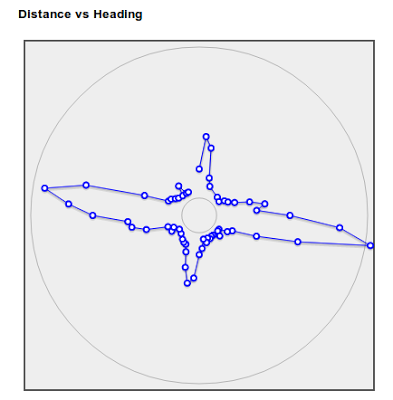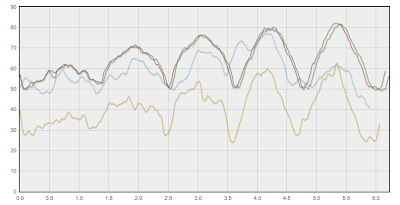My Locosys Genie GT-31 died after logging nearly 100 days of data in 2.5 years.
For a few weeks I used my iPhone and was very unhappy with the accuracy of the resulting logs, having been spoiled by the extremely accurate GT-31.
So it was time to get a running watch and the choice was between a Garmin Forerunner 210 and the Magellan Switch Up. The Switch Up has a lot more features than the Forerunner but is much newer and less tried and true.
DC Rainmaker did a full review of the Switch Up, so I'll only look at a few tests that show the accuracy of the resulting logs, which was my main concern when buying it and as it happens, not really a strong point of the Switch Up.
Unfortunately, without another GPS watch to compare it to directly, it's hard to know if this is a failure of the Switch Up in particular or running watches in general.
The best I could do was to run two laps of the same route, the first with the Switch Up in a shoulder pouch, the second with it worn as a watch.
I then compared these two logs against one recorded by the iPhone and one from the GT-31. All maps and graphs were generated with my site, GPSLog Labs.
MAPS
The route I ran is all straight segments up and down a series of increasingly steep streets. This makes a good comparison as it's obvious if the logger is recording the straight path. There aren't too many trees along the streets and no tall buildings to block the GPS signal.
GT-31

The GT-31 records the streets as nice straight lines, doesn't cut off the corners and the segments that are re-run generally overlap. The south side of each street seems to waver a little more than the north, possibly because when running west with the logger on my left shoulder, there are less satellites in view.
iPhone

The iPhone really "rounds" out the log, cutting the turnarounds short and generally doing a very rough job. It almost certainly isn't getting a position fix every second like the other loggers. It's only a 3GS and suspect a newer iPhone would probably do better.
Switch Up (shoulder pouch)

The Switch Up records a very wobbly path. The turnarounds are at the right points, but repeated segments don't overlap, and again, the north side of the streets seems to be slightly straighter than the south.
Switch Up (watch)

Thankfully, when the Switch Up is worn as a watch it seems that it actually performs slightly better, probably due to a more all round view of the sky, otherwise many of it's useful features would be negated.
DISTANCE
This inaccuracy in the recorded position has a fairly negative effect on the resulting recorded distance, all those little wobbles increase the distance by about 2%. If this was your only watch then you wouldn't care, but if you've got a few thousands of kilometers of running logged already, it's annoying to no longer be able to compare them easily.
The following table compares the iPhone and the Switch Up to the 29 logs of this route I got with the GT-31:
| Count | Average Distance | Standard Dev | Difference |
| Locosys Genie GT-31 | 29 | 6067.6 m | 33.13 | |
| iPhone 3GS | 3 | 5973.3 m | 70.24 | 98.45% |
| Magellan Switch Up | 2 | 6190.0 m | 42.43 | 102.02% |
Obviously, with only 2 logs from the Switch Up it's a bit early to nail down the extra distance, but in both cases the measured distance would be a far outlier for the GT-31:
 SPEED
GT-31
SPEED
GT-31

The GT-31 sets the baseline, but even it's recorded speed bounces around a bit. The dark blue line shows the median over a 25 second window, the pale blue line is the actual speed from the logger.
The histogram has a fairly tight cluster of speeds, bearing in mind that this route is up and down hills so the speed should vary a bit.
iPhone

The worst case is the iPhone, with the speeds varying by more than 10km/h in a few seconds. Even after taking the median the speed still jumps around wildly and the histogram is a mess.
Switch Up (shoulder pouch)

The Switch Up's speed is much better than the iPhone, especially once an average is taken.
Switch Up (watch)

There's no appreciable difference between wearing it on your wrist or in a shoulder pouch, but in practice it still means that if you look at the instantaneous pace readout you're likely to be seeing a value that's incorrect by anywhere up to 1 min/km. This means that the only way to really pace yourself is to use the auto-lap timer and use the lap averages.
HEADING
The Heading vs Time graphs really should be alternating between steady east and steady west and the Distance vs Heading should be a nice sharp elongated cross.
GT-31

 iPhone
iPhone


The iPhone actually performs quite well on this measure because it's obviously taking less frequent readings and doing some kind of interpolation between them.
Switch Up (shoulder pouch)

 Switch Up (watch)
Switch Up (watch)

 ALTITUDE
ALTITUDE
Thankfully, there is one area where the Switch Up shines due to it's barometric altitude sensor.

The green and red lines are from the Switch Up, both laps are nearly identical and the hills look nice and symmetrical.
The yellow line is from the GT-31, and the blue from the iPhone.
When all records from the GT-31 are plotted together, the overall shape becomes clearer, though it seems that the Switch Up is still only providing consistent relative altitudes rather than an accurate absolute altitude:

There aren't many laps recorded on the iPhone, but the altitude is all over the place anyway:
 CONCLUSION
CONCLUSION
Without using another GPS watch in a direct comparison, it's hard to really rate the accuracy of the Switch Up. My only other experience with GPS watches is with the
GlobalSat GH-615M, which created a very similar log to that of the GT-31 when I did a run with them together a couple of years ago (both use the same SiRF Star III chipset).
Feature and price-wise the Switch Up is fine, so maybe the accuracy can be improved with a firmware update since it's using the SiRF Star IV chipset which is hopefully better than the III. (Note that these logs were created with the version 19.48 firmware.)
YMMV.
UPDATE 1-Feb-2013
Unfortunately there was something faulty with my Switch Up and I've returned it. It was freezing up, sometimes after only a few hundred meters, and had to be turned on and off and the activity reset before it would record again. This was pretty frustrating, but before it died, I made a few more tests and did find I was able to improve the accuracy some what by ensuring I wore the watch on the hand that was going to "see the most sky" on the particular route I was running.
I decided to replace the Switch Up with a
Garmin Forerunner 210, which I'm very happy with. The Garmin has fewer features than the Switch Up, but it's very easy to use and reliable. I also purchased another
Locosys Genie GT-31 for use as a non-running logger, since it's accuracy and long battery life are fantastic.
The accuracy of the Garmin has been very good: The distances are pretty much spot on what I was getting from the GT-31, the instantaneous pace is pretty good. It's altitude readings can't compare to the Switch Up, and the heart rate logs seem a little less detailed but overall it's great value.
One thing I've found is that it pays to wait around a bit after the satellite signal has been acquired before you start (e.g. until it displays a zero speed) as it's pretty optimistic about when it has a "lock".























